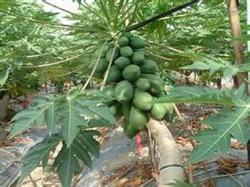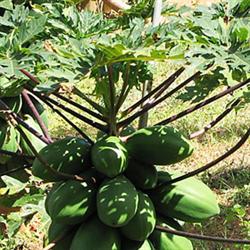The cultivation of papaya
Planting and cultivation 1, selecting and preparing land to plant in places with plenty of sunshine, fertile soil, moist soil and good drainage, and can also be planted in the corner of the field, hillside, front and back of the house. When cultivated in pieces, holes are opened according to the row spacing of 1 meter × 2 meters. 5 kilograms of farm manure and soil are applied to each hole as base fertilizer. The nursery land should choose loose and fertile sandy loam, apply 3000 kg of farm manure per mu as base fertilizer, turn 25 cm deep, plough fine and level, and form a border 1.3m wide. 2. The method of propagation is mainly divided into plants, and can also be propagated by cuttings and seeds. The main results are as follows: (1) Chaenomeles papaya has shallow roots and strong tillering ability, and many young plants can grow from the roots every year. The young plants sprouting around the old ones were dug out with roots before March. The smaller ones can be planted in the nursery first, then cultivated for 1-2 years, and then planted in the nursery; the larger ones can be planted directly. This method has the advantages of early flowering and fruiting, simple method and high survival rate. (2) before cutting propagation for 2-3 months before sprouting, cut the robust and tender branches, cut them into small segments 15-20 cm long, obliquely insert them in the seedling bed according to the row spacing of 10 cm × 15 cm, properly shade, often keep moist, wait for the new roots to grow, transplant to the seedling field and continue to cultivate for 1-2 years. (3) seed reproduction, autumn sowing or spring sowing, autumn sowing in late October, when the papaya seeds are mature, pick the fruit, take out the seeds, open holes in November according to the row spacing of 15 cm × 20 cm, hole depth 6 cm, sow 2-3 seeds in each hole, cover fine soil 3 cm. Spring sowing is from early to late March, first soak the seeds in water for 2 days and then fish them out, put them in a basin, cover them with a wet cloth, put them in a warm place for 24 hours, sow seeds according to the above method, and spring sowers emerge in spring in the second year, and spring sowers emerge from late April to early May. When the seedling is about 1 meter long, it can be planted in the nursery. 2-3 seedlings were planted in a triangle in each hole, compacted and watered with soil cover. Spring is the best time to plant trees. 3. Field management (1) after ploughing, weeding and planting survived, weeding and weeding twice a year in combination with fertilization in spring and autumn, loosening the soil and removing weeds. Pine trees should be cultivated at 10:00 in winter to prevent freezing. (2) topdressing once before flowering in spring. First open a ring ditch around the tree, each plant applied coke mud and soil fertilizer each of about 5 kg, or about 10 kg of human feces and urine, in order to promote growth and facilitate flowering and fruiting. (3) pruning has a great influence on the flowering and fruiting of papaya, which should be carried out from December to March of the following year. Adult trees are pruned once a year, cutting off diseased branches, dead branches, old branches and overdense young branches, so as to keep the tree shape hollow and round, so as to blossom and bear more fruit. The old trees that have been more than 10 years old and have begun to weaken should be renewed. Before freezing, all the aboveground parts can be cut off to let the old roots grow seedlings and cultivate into new plants.
- Prev

Cultivation techniques for high yield of papaya
Papaya belongs to the genus Chaenomeles of Rosaceae. It is an ancient local variety in Linyi. Its fruit is rich in nutrition and has high medicinal value. In 2003, Caozhuang Town introduced 1000 mu of papaya, mainly Luo Fu and Changjun. At present, the growth is good, now China Agricultural Network will introduce the cultivation techniques of high-yield papaya in the field, such as.
- Next

Management of cultivation techniques of papaya
(1) varieties. Papaya varieties. (2) Land conditions. From 300m to 900m above sea level, the soil type is yellow brown soil, the thickness of soil layer is more than 50cm, the pH value of soil is 5.3cm to 7.0m, and the content of organic matter ≥ is 1.0%. (3) cultivation and management. 1. Seedling breeding: seedling propagation. The seedling is divided.
Related
- Moge, come on! The staff of the peasant association in the producing area of cantaloupe were frightened when the crowd gathered.
- Causes and Solutions of low Fruit setting rate of Apple
- Symptoms and control measures of passion fruit virus disease
- Fruit growing lesson: how do apple orchards keep high yields?
- Can you build orchards in the mountains? What are the pros and cons?
- How to manage the coloring period of Crisson grape?
- This paper introduces the processing technology of two kinds of fig products.
- How much is a month for retired teachers in rural areas by 2020?
- How can strawberry planting increase sugar content? We should pay attention to management in many aspects.
- What are the cultivation techniques on how to improve the yield of golden fruit?

